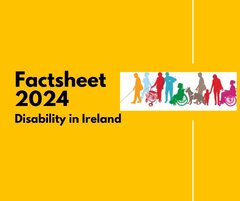Disability in Ireland - Factsheet 2024
Issued on January 26 2024

Disability in Ireland Factsheet 2024
This factsheet outlines key demographic statistics on disability in Ireland. While education levels are improving for disabled people, disability continues to increase a person’s risk of poverty, reduces employment opportunities and results in poorer health outcomes. The factsheet also sign-posts the original data source for further reading.
One in five people report having a disability
The number of people who have a disability or disabling condition is increasing. In Census 2022 1,109,557 people (22% of the population) reported having a long-lasting condition/difficulty or disability to any extent 1, compared to 2016 2, when 643,131 people indicated that they had a disability. 3
Of the current 22% of the population:
- 8% report experiencing at least one long-lasting condition/ difficulty ‘to a great extent’ or a lot.
- 14% report experiencing at least one long-lasting condition/ difficulty ‘to some extent’ or a little. 4
- The proportion of people experiencing a long-lasting condition or difficulty increases exponentially with age:
- 4% of people aged 0 – 4 years.
- 76% of people aged 85+ years. 5
- 70% of people with a disability aged 20-64 acquired their disability after the age of 16 years. 6
Income and Poverty
Among people unable to work due to a long-standing health problem (disability):
- 2 in 5 are at risk of poverty.
- 1 in 5 live in consistent poverty.
- 1 in 2 (44.3%) live in deprivation. 7
The additional cost of living with a disability is well documented. It was estimated, in a report published by the Department of Social Protection in 2021, to be between €8,700 - €12,300 a year. 8 This estimate of the extra Cost of Disability predates the recent high levels of inflation (19.3% from 2021-23 according to the Consumer Price Index Inflation Calculator) 9. As a result this estimate has likely increased to a range of €10,379 – €14,673.
Health
- 25% of disabled people report that their health status is ‘Bad or Very Bad’ compared to the State average of 4%.10
- 43% of disabled people aged over 15 years report some level of depression, well above the State average of 14%.11
- The standardised mortality rate for persons with disabilities is 4.1 times higher than that of people without disabilities.12
Employment
Ireland ranks the lowest of the EU for:
Disability employment rate:
- 32.6%, almost 20% below the EU average of 51.3%.
Disability employment gap:
- 38.6%, significantly higher than the EU average of 24.4%.
- The disability employment gap for women is 45%.13
Education
- 14.4% of disabled people over 15 who have ceased their education only completed primary level education, compared to 7.4% of the general population. 14
- The figures in education are improving however. In 2020/2021, 12.4% of new entrants to higher education were students with disabilities, compared to 5.4% of new entrants in 2011/2012. 15
- The number of students in higher education registered with disability support services has increased by 273% since 2008/2009. 16
Housing
Disability is the main category of need for 9.5% of all households on the social housing waiting list (5,521 households). 17
From 2016 to 2020, the number of people on the general social housing list reduced by almost a third, while the number of people with a disability basis of need on the waiting list reduced by significantly less (12%). 18
References:
1 CSO (2023) Census of Population 2022
2 Note: In Census 2022, the two questions on ‘long-lasting conditions and difficulties’ were revised. The information reported was compiled from a range of categories in the questions relating to ‘long-lasting conditions and difficulties’ and the ‘extent to which they were experienced’. The difficulties ‘included those experienced due to old age’. In Census 2016, a disabled person was classified as someone who responded 'yes' to any of several categories across two questions on long-lasting conditions and difficulties.
3 CSO (2017) Census of Population 2016
4 CSO (2023) Census of Population 2022
5 ibid
6 National Disability Authority (2019) Retaining people with a disability in the workforce
7 CSO (2023) Survey on Income and Living Conditions 2022
8 Indecon (2021) The Cost of Disability in Ireland (pg. 135)
9 CSO CPI Inflation Calculator https://visual.cso.ie/?body=entity/cpicalculator
10 CSO (2022) Irish Health Survey 2019 – Persons with Disabilities
11 ibid
12 National Disability Authority (2021) Overview of UNCRPD Article 25 in Ireland (pg.6)
13 European Disability Forum (2023) European Human Rights Report Issue 7 (pg.30-32, 35)
14 CSO (2023) Census of Population 2022
15 Higher Education Authority (2022) National Access Plan: A Strategic Action Plan for Equity of Access, Participation and Success in Higher Education 2022-2028
16 AHEAD, Students with Disabilities Engaged with Support Services in Ireland 2021/22
17 The Housing Agency (2023) Summary of Social Housing Assessments 2022 (pg.30)
18 The Housing Agency (2021) Analysis of Households with a Disability Basis of Need for Social Housing 2015-2020 (pg.5)
ENDS
Updated: 26 January 2024
